20 tanks a year would likely be a reasonable build rate, to allow for a few spares and older models to be retired and some for PRes units to train. However I suspect that 10 would be the likely number.
To me that's part of the key of what Canada can handle. I don't want to minimize the complexity of the military manufacturing process - there will probably always be some items that have to be subcontracted out, like barrels. But low rate and continuous production is what matters.
We do not need large quantities but any manufacturer wants to see a reasonable rate of return on an investment. If a manufacturer can see a steady flow of business for a ten or twenty years period then they will invest. If its a crap shoot at the possibility of a two to three year feast followed by two decades of famine then not so much.
There's a certain rhythm in building custom vehicles. The RV industry is a master at this. Just take a look at the factories around Elkhart, Indiana. It has numerous small scale assembly lines and a host of parts manufacturers. Obviously there is a difference in type and scale, but the system of low-run production would work so long as there is a long term commitment to acquire which would let the assembly plant and supply chain see a steady work flow. An alternative is to go back to a federal arsenal system.
Something like that needs to scale to the CF requirements which means we need to make long term predictions for force structure (ESPECIALLY EQUIPPING THE RESERVES).
Just for a hoot, If I use the two division model I prefer (1 light/medium, 1 heavy) and with a service cycle of 10 years heavy RegF usage, 15 years light ResF usage per vehicle, you could probably do a predictable cycle like:
tanks - 3 regiments 200 total - 20/year - initial build followed by refit or replacement
IFVs - 6 battalions 400 total (common chassis with tank) - 40/year - initial build followed by refit or replacement
SP artillery - 4 regiments 100 total (common chassis with tank) - 10/year - initial build followed by refit or replacement
Tracked MPV (CP, logistics, etc) 500 total (common chassis with tank) - 50/year - initial build followed by refit or replacement
LAVs - none initially needed but 6 battalions 40/year for refit or replacement
ACSV - none initially needed but 6 battalions 40/year for refit or replacement
Towed artillery - 2 regiments using current M777 / LG1 systems - no domestic industry and handle replacement FMS
SMP Wheeled fleet - appx 3,000 (including medium and heavy logistics, light infantry transport and miscellaneous - 4 common chassis maximum) - 300/year - initial build followed by refit or replacement.
Essentially you are looking at three major facility groups - one tracked continuously producing 120 vehicles per year; a LAV/ACSV facility producing 80 vehicles per year; an SMP wheeled facility producing some 300 vehicles per year; and spare parts and 3rd and 4th line maintenance. That is a scale Canada's industry and budget should be able to handle.


www.volvogroup.com
www.arquus-defense.com
www.mackdefense.com

prevostcar.com
novabus.com


